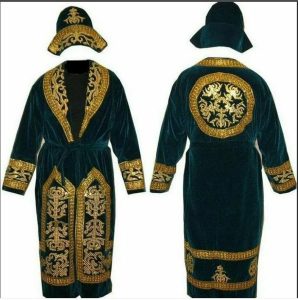




Among the special and expensive clothes of Kazakhs is the chapan (shapan), which is an active participant of the gift exchange institute to this day. In Kazakh culture, gifting a chapan has a ceremonial and ritual significance. In one case it is a sign of respect, in another it is a recognition of a talent (e.g. an akyn, a fighter, etc.), in the third it is a “nail chapan” used to “nail down” the original marriage contract, sometimes gifting chapan also means making amends, which is expressed by the traditional expression “at-shapan aiyp” (analogous to a fine), etc.
In general, chapan is the most common type of clothing worn by both men and women. It is sewn from different fabrics, light and thick, in different colours. It was a universal garment worn both in winter and summer by young and old people of both sexes.
For older people it was usually plain and of darker colour. A wedding shapan had a special symbolic meaning, decorated mainly with rich floral ornaments with zoomorphic elements. The type of embroidered patterns and the colour of the chapan varied regionally, and the whole decoration was interpreted as a wish for fertility, happiness, wealth, etc.
The chapan of Kazakh nobility was distinguished by the richness of fabrics, decorations and borders. Here, the ornamental decoration was distinguished by exquisite elegance and was usually executed in a tree-like, multivariate form. Such chapanes were made of velvet or crimson fabric in various shades of red (purple, scarlet, terracotta, crimson, etc.), the colour once again emphasising the status of the owner.


